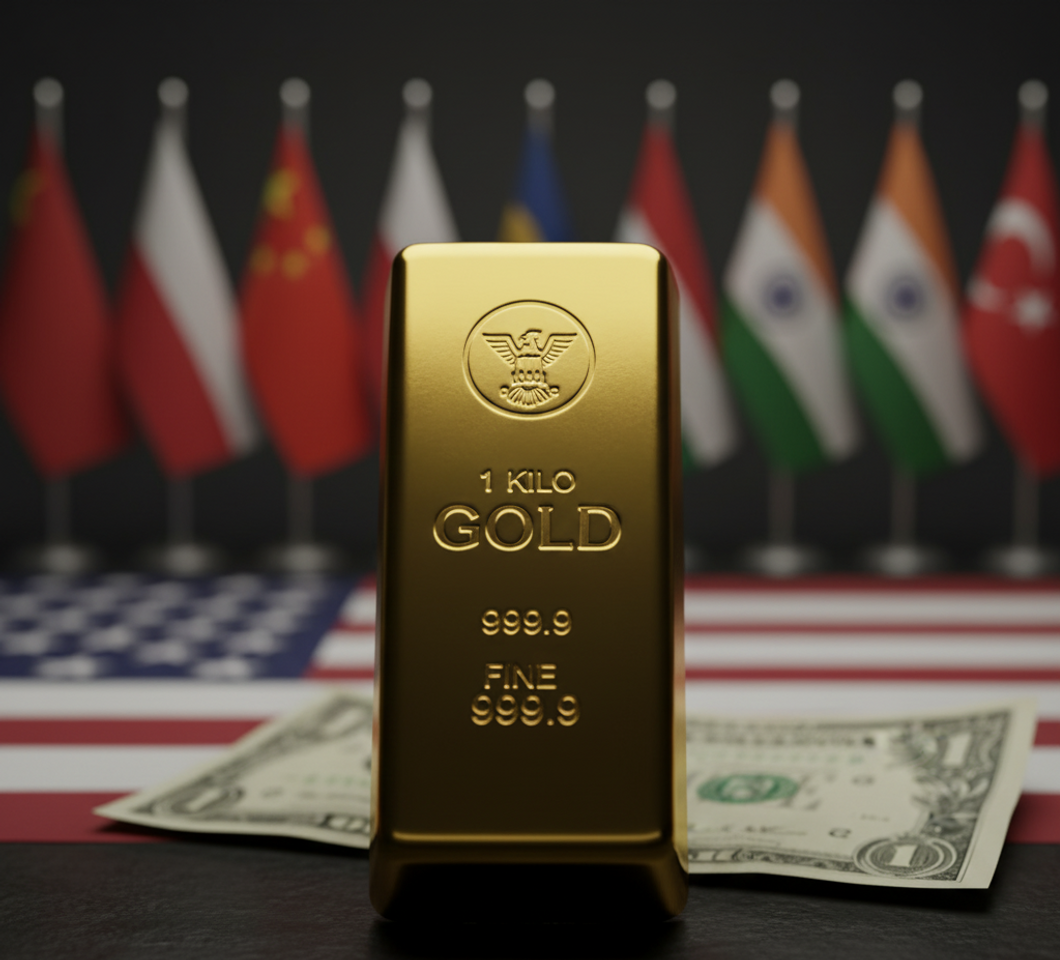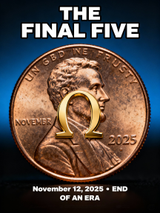De-Dollarization: How Central Banks Are Fueling the Next Chapter for Gold
Introduction: The Silent Titans of the Gold Market
While the financial press and retail investors fixate on gold's record-breaking prices, tracking daily fluctuations and exchange-traded fund (ETF) flows, the most powerful and consequential player in the market operates with strategic patience and immense scale, largely away from the public glare. This player is not a hedge fund titan or a speculative consortium, but the collective force of the world's central banks. Their recent activity in the gold market is not a tactical trade; it is the physical manifestation of a profound, multi-decade geopolitical and economic strategy known as "de-dollarization".
The unprecedented and accelerating wave of central bank gold accumulation represents a deliberate, long-term strategic realignment of the global financial order. This monumental shift, driven by a confluence of escalating geopolitical risks and eroding confidence in the U.S. dollar's long-term stability, is systematically re-establishing gold's foundational role as a core monetary asset. In doing so, it is providing a powerful, sustainable, and structural support for the current gold bull market, distinguishing it fundamentally from speculative rallies of the past.
The Unraveling of Dollar Hegemony: Understanding De-Dollarization
To comprehend the sheer scale of official sector gold demand, one must first understand the powerful forces compelling this strategic pivot. The trend is rooted in a calculated move away from the post-Bretton Woods monetary system, which for over half a century has been defined by the "exorbitant privilege" of the U.S. dollar.
A. Defining the Great Diversification
De-dollarization is a conscious and strategic process undertaken by sovereign nations to systematically reduce their reliance on the U.S. dollar. This process unfolds on two primary fronts: first, in settling international trade, and second, and most critically for the gold market, in the composition of their foreign exchange reserves.
B. The Geopolitical Catalyst: Sanctions and the Quest for Financial Sovereignty
While the de-dollarization trend has been developing for years, its most potent accelerant has been the increasingly frequent and far-reaching use of the dollar-based financial system as an instrument of foreign policy—a phenomenon often described as the "weaponization of the dollar".
The decision by the U.S. and its allies to freeze nearly half of Russia's $640 billion in foreign currency reserves following the 2022 invasion of Ukraine served as a watershed moment for central bank reserve managers globally.
This realization has created a powerful feedback loop. The very act of wielding the dollar as a weapon is creating a strategic imperative for nations to find alternatives, which, over time, inherently weakens the effectiveness of those sanctions. Rational state actors, particularly major U.S. rivals like China and Russia, as well as a growing bloc of non-aligned nations within frameworks like BRICS, are now fundamentally re-evaluating their reserve strategies to mitigate this "political counterparty risk".
C. The Economic Undercurrent: U.S. Debt and Fissures in Global Confidence
Layered on top of these geopolitical drivers is a powerful economic rationale for diversification: the deteriorating fiscal health of the United States. The trajectory of U.S. national debt has become a source of profound concern for its international creditors. The total national debt has surged past $37 trillion, a figure that now exceeds 122% of the nation's Gross Domestic Product (GDP).
A particularly alarming fiscal threshold was crossed in fiscal year 2024, when the U.S. government's net interest payments on its debt—costing $879.9 billion—exceeded its spending on national defense.
This quiet vote of no-confidence is visible in the market for U.S. debt. The share of foreign ownership of U.S. Treasury securities has been in a steady decline, falling from a peak of over 50% during the Global Financial Crisis to approximately 30% in early 2025.
These geopolitical and economic drivers are not separate; they are symbiotic and mutually reinforcing. The geopolitical desire to evade sanctions provides the initial impetus for de-dollarization. The alarming U.S. fiscal picture provides the financial justification. This allows countries like China and its allies to frame their diversification away from the dollar not as an aggressive political challenge, but as a prudent and defensive financial strategy. It is a necessary measure to protect their national wealth from the dual risks of political seizure and a potential U.S. debt crisis or currency devaluation.
D. The Data Story: A Quantifiable Shift in Global Reserves
This strategic shift is not theoretical; it is clearly visible in the official data on global reserve holdings. According to the International Monetary Fund's Currency Composition of Official Foreign Exchange Reserves (COFER) data, the U.S. dollar's share of allocated global reserves has fallen from a peak of over 71% in the early 2000s to approximately 57.7% as of the first quarter of 2025.
Crucially, this decline has not primarily benefited the dollar's traditional fiat currency competitors, such as the euro, yen, or pound sterling. Instead, a significant portion of the shift has been toward gold and a basket of "non-traditional" reserve currencies like the Canadian dollar, Australian dollar, and Chinese renminbi.
| Currency/Asset | Share of Global Reserves (c. 2000) | Share of Global Reserves (Q1 2025) |
| U.S. Dollar | ~71% | 57.74% |
| Euro | ~18% | 20.06% |
| Japanese Yen | ~6% | 5.15% |
| British Pound | ~3% | 5.19% |
| Chinese Renminbi | N/A | 2.12% |
| Other Currencies | ~2% | 9.75% |
| Gold (as % of total reserves) | ~8% | ~15% |
Sources: IMF COFER data
A New Gold Standard: The Unprecedented Scale of Central Bank Accumulation
The strategic decision to de-dollarize has translated into a physical gold buying spree of historic proportions. This section details the scale and acceleration of this accumulation, which marks a fundamental reversal of decades-long central bank policy.
A. From Sellers to Hoarders: A Generational Reversal
The current trend represents a complete paradigm shift in the official sector's attitude towards gold. For two decades, from 1989 to 2009, central banks were consistent net sellers of the metal, viewing it as a legacy asset with little role in a modern financial system. This period was characterized by agreements like the Central Bank Gold Agreements, designed to manage these sales in an orderly fashion. However, the 2008 Global Financial Crisis acted as a catalyst for change. Since 2010, central banks have transformed into aggressive and consistent net buyers of gold, a streak that has now extended for 15 consecutive years.
B. Quantifying the Rush: The Thousand-Tonne Trend
While the buying trend began in 2010, the pace has accelerated dramatically since 2022, coinciding with the escalation of geopolitical tensions. Central banks have entered a new phase of accumulation, with net annual purchases consistently exceeding 1,000 metric tonnes—a level of buying unseen since the end of the Bretton Woods gold standard system in 1971.
The numbers, as reported by the World Gold Council, are staggering:
-
2022: Net purchases reached a multi-decade record of 1,136 metric tonnes.
3 -
2023: The buying continued at a furious pace, with a net total of 1,082 metric tonnes.
3 -
2024: The trend was solidified with another massive year of accumulation, totaling 1,045 metric tonnes.
19
This is not a temporary blip. These figures, which far exceed the annual average of 473 tonnes recorded between 2010 and 2021, establish a new, elevated baseline of demand from the world's most powerful financial institutions.
C. The New Vanguard: Identifying the Key Institutional Buyers
This historic buying spree has been led primarily by emerging market central banks, who are most acutely motivated to reduce their dependency on the U.S. dollar. The key players in this new gold rush are a clear reflection of the shifting geopolitical landscape.
| Year | Total Net Purchases (Metric Tonnes) |
| 2022 | 1,136 |
| 2023 | 1,082 |
| 2024 | 1,045 |
Top Buyers (2022-2024):
-
People's Bank of China (PBoC): Officially the most significant buyer, the PBoC has reported continuous monthly purchases for over 18 months, adding hundreds of tonnes to its declared reserves. Many analysts believe its actual purchases, conducted covertly, are substantially higher.
3 -
National Bank of Poland (NBP): The largest single buyer in 2024, Poland has been a vocal proponent of increasing its gold reserves, with a stated goal of raising gold's allocation to 20% of total reserves.
19 -
Central Bank of the Republic of Turkey (CBRT): Despite domestic economic challenges, Turkey has been one of the most consistent and large-scale buyers of gold over the past several years.
3 -
Reserve Bank of India (RBI): India has dramatically increased its pace of accumulation since 2022 as part of a strategic diversification program, becoming a major force in the market.
3 -
Other Significant Buyers: A long tail of other nations, including Singapore, Iraq, Uzbekistan, and the Czech Republic, have also been notable and consistent purchasers, demonstrating the broadening base of this trend.
4
Even some developed nations are beginning to alter their long-held policies. Japan made its first significant gold purchase in over 50 years in late 2024, and Germany has halted its historical selling program, signaling that the logic of holding gold is gaining traction across the entire global central banking community.
The Rationale for Bullion: Why Gold is the Asset of Choice
As central banks execute their de-dollarization strategies, they are overwhelmingly choosing gold over other currencies or assets. This preference is not arbitrary; it is based on gold's unique and timeless characteristics as the ultimate form of sovereign money.
A. The Ultimate Neutral Territory: An Asset Without Counterparty or Sovereign Risk
The foundational appeal of gold in the current environment is that it is the only major financial asset with zero counterparty risk.
When a central bank holds physical gold bullion, particularly when stored within its own national vaults, that asset is truly and completely sovereign. It is immune to the primary risks driving de-dollarization: it cannot be devalued by another country's monetary policy, it cannot default, and, most importantly, it cannot be frozen or seized through financial sanctions.
B. An Anchor in the Storm: Gold's Enduring Role as a Hedge
With a history as a store of value spanning millennia, gold is the world's most proven hedge against the long-term erosion of purchasing power that affects all fiat currencies.
C. A Liquid Asset for Crisis Management and International Settlement
While gold is primarily being accumulated as a long-term strategic holding, it does not sacrifice utility. It remains a highly liquid asset, recognized and accepted globally. In a severe financial crisis, gold reserves strengthen a central bank's balance sheet, providing credibility and stability. This enhances a nation's ability to manage its currency, settle international debts, and provides critical flexibility in monetary policy when conventional tools are insufficient.
Structural Impact on the Gold Market: A New and Enduring Demand Pillar
The strategic shift by central banks is not just another factor influencing the gold price; it represents a fundamental and structural alteration of the entire gold market. This institutional-led demand is creating a market dynamic that is profoundly different from previous bull cycles.
A. Building the Foundation: How Institutional Buying Creates a Resilient Price Floor
Central bank demand is strategic, long-term, and largely insensitive to short-term price fluctuations. These institutions are not trading for quarterly profits; they are accumulating a core strategic position intended to be held for decades.
B. A Quarter of the Market: Analyzing the Sheer Weight of Central Bank Demand
The sheer scale of this new demand pillar cannot be overstated. According to market analysis, central banks now account for approximately 25% of all annual global gold demand.
This dynamic is creating a structural collision in the market. On one side, there is the relatively inelastic nature of new gold supply. Bringing large-scale mines into production is a capital-intensive and time-consuming process, meaning annual mine output grows very slowly.
C. Beyond Retail Fear: Why This Bull Market is Fundamentally Different
Previous gold rallies, such as the one following the 2008 financial crisis, were often characterized by sharp spikes in Western retail investment and ETF inflows. These rallies were primarily driven by short-term fear and a flight to safety among private investors. While that demand is important, the current bull market is underpinned by a far more powerful and enduring force: the deliberate, strategic, and ongoing re-monetization of gold by the world's largest and most conservative financial institutions. This suggests that the current cycle has a much more solid and sustainable foundation than those driven by more speculative, sentiment-based flows.
Conclusion: Gold's Re-Emergence in a Multipolar Monetary World
The evidence is clear and compelling. The global trend of de-dollarization, catalyzed by a potent combination of geopolitical strategy and mounting concerns over the United States' long-term fiscal stability, has become a powerful, structural, and enduring driver for the gold market. The historic levels of buying by the world's central banks are not a temporary market anomaly but the tangible result of a multi-year strategic realignment of the global monetary system.
This strategic shift by sovereign institutions provides an exceptionally solid foundation for the current gold bull market. It suggests that this cycle is more sustainable and fundamentally sound than previous ones that were heavily reliant on more speculative retail and ETF flows. The persistent, price-insensitive demand from the official sector is fundamentally altering the market's structure, creating a resilient price floor and a long-term tailwind for valuation.
We are witnessing the early stages of gold's re-emergence as a neutral, foundational cornerstone of an increasingly multipolar international monetary system. Its role is visibly shifting from that of a peripheral "safe haven" asset, to be held only in times of acute crisis, to that of a core, indispensable component of sovereign financial strategy for the 21st century.
Explore Popular Articles
The Collector's Hierarchy
The Collector’s Hierarchy Understanding Issued, Specimen, and Proof Banknotes In the sophisticated...
The Great Revaluation: Strategic Outlook on Commodities, Equities, and the Return of Tangible Assets (2025–2026)
Executive Summary: The Pivot to Tangible Value The global financial architecture is currently navi...
The Final Five: Inside the Last U.S. Pennies Ever Minted (And Why They Could Be Worth Millions)
November 12, 2025, marks the end of an era that began in 1792. On a crisp autumn morning in Washing...




